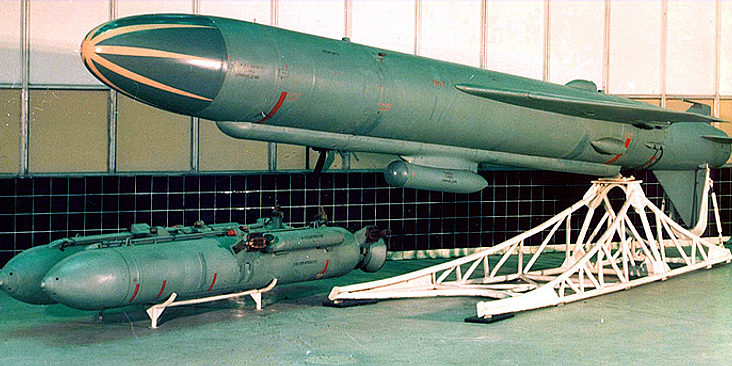Facts
| Russian/NATO Designation | SS-N-9 Siren/P-120 Malakhit |
| Variants | P-70 Ametist |
| Mobility and Role |
Ship- and Submarine-Based/Surface-to-Surface Anti-Ship Cruise Missile Max speed of 265 m/s; Mach .9 |
| Designer/Producer | NPO Mashinostroyeniya Chelomey |
| Range | 110km from surface ship; 70km submarine VLS |
| Warhead Type and Weight |
Conventional or Nuclear Conventional warhead reportedly between 500-1000kg |
| Yield |
500kg conventional HE warhead; 200 kT Nuclear warhead |
| Guidance System/Accuracy | Inertial terminal homing; infrared seeker; L-band active radar seeker |
| Cruise Altitude | 100-200m mid-flight; 40-60m at terminal stage |
| Propellant | Solid-fuel booster; turbojet sustainer |
| IOC/Retirement |
Introduced in 1969; operational in 1972 Still operational, although production has ceased in favor of P-270 Moskit |
| Status/Number of Units | 500 reportedly produced/Still operational on corvettes |
| Launch Vehicles |
Charlie II class submarine (decommissioned); Nanuchka class corvette; Tarantul class corvette |
Overview
Based on the P-70 Ametist, the P-120 Malakhit (SS-N-9 Siren) is a medium-range anti-ship cruise missile designed by the Soviets in the late 1960’s to enable the Charlie II class submarine to fire without surfacing. The P-120 was originally designed for VLS submarine launch, but was retrofitted for surface launch from Nanuchka and Tarantul class corvettes. It was first employed in 1972 on Project 1234 Nanuchka I class corvettes. The cruise missile begins its flight by climbing to an altitude reported between 100-200m and using an inertial navigational seeker to identify targets. The missile uses a solid-fuel booster to achieve altitude and then transitions to a turbojet engine to each cruising speeds of up to Mach 0.9. The active radar seeker allows the P-120 Malakhit to hit targets without guidance from the launch point, and the IR seeker, located in a ventral pod, acts as a backup guidance system resistant to jamming. At approximately 10km from the target, The P-120 drops to between 40-60m and delivers a powerful conventional 500kg payload. The P-120 is also capable of delivering a 200kT nuclear warhead.
Strategic Implications
The Russian navy has decommissioned all Charlie II class submarines, but the P-120 Malakhit is still equipped on Nanuchka and Tarantul class corvettes. Two P-120 Malakhit cruise missiles destroyed a Georgian patrol boat in the 2008 conflict. The IR seeker contingency allows the missile to avoid radio-electronic countermeasures and find targets even if the launch ship has been compromised. The relatively short range of the P-120 makes it ineffective against more advanced navies. Although still in use by the Russian navy, production of the P-120 Malakhit has ceased in favor of the newer P-270 Moskit missile (NATO designation S-N-22 Sunburn), which has a longer range and more advanced features.
Sources:
http://www.ausairpower.net/APA-Rus-Cruise-Missiles.html#mozTocId39941
https://fas.org/nuke/guide/russia/theater/ss-n-9.htm
http://weaponsystems.net/weaponsystem/HH10%20-%20P-120%20Malakhit%20(SS-N-9%20Siren).html
http://cmano-db.com/pdf/weapon/1480/
http://www.deagel.com/Offensive-Weapons/P-120_a000783001.aspx

